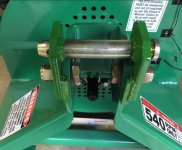spurlocktool
Bronze Member
I've left a short report in the "Reviews" section, but thought I would give a more detailed report here. I've owned a BearCat 73554 chipper/shredder for several years and use it to chip orchard prunings and general tree trimmings around the property. I've always wished for a hydraulic feed feature so when I saw the WoodMaxx I read reviews and ordered it up.
I've only used it 4+ hrs. but so far am very impressed with its quality and performance. It is light years ahead of the BearCat in ease of use and safety. The hydraulic feed roller is very aggressive and pulls material in at a controlled rate rather than dangerously jerking it out of your hands as on hand fed models. Y shaped branches feed through fine if flexible but need trimming if large and stiff. I chipped mostly live oak limbs which have very erratic side branching at all angles. The widest spreading 3/4" or larger side branches had to be trimmed but more flexible stuff went right through. Bottom line is feeding is way easier and safer than the BearCat. I would never go back to manual feed.
I was not sure how well my little BX2230 would power it, thinking I would have to reduce the feed speed on larger wood. But surprisingly it barely loads the tractor when running 3" oak or 4" pine through at the highest feed speed.
Another surprise was that the engine just briefly loads when engaging the PTO at idle. With the BearCat I had to bring the idle up a bit, then engage/disengage/engage/disengage/engage to gradually get the chipper flywheel rotating without killing the engine. The Woodmaxx runs smooth with very little vibration and is also quieter than the BearCat.
Here are the problems/quirks that I have found so far:
- As delivered the feed roller would not reverse. This was caused by the safety bar stop bolts not allowing the hydraulic valve to move into the reverse position. Correcting was just a simple adjustment, but I also added flat washers under the nuts to better hold adjustment.
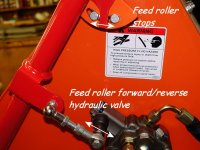
- The threaded shaft between hydraulic valve and safety bar was too long, causing the bar to sit beyond the top of the hopper when in feed position. Side branches would bump the bar into neutral, stopping the feed. So I shortened the shaft so the bar sits below the rim of the hopper as shown below.
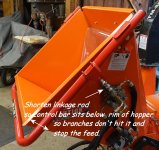
- The hopper does not line up exactly with the feed roller housing as shown below. Not a big deal, but I could see branches would sometimes hang up so I used an angle grinder to bevel the ledge.
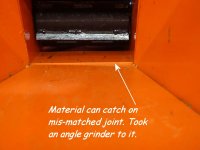
- Small branches would sometimes catch in the slots at the top corners of the hopper as shown below, stopping the feed. This happened often enough that I welded in 1/2" round rod to close the slots.

- As others have mentioned, the safety bar would sometimes fall into neutral if a large branch started bouncing. So I added a simple rubber bungee to the bar to act as a spring, counteracting the weight of the bar. This seems to have solved the problem, but I may switch to a screen door spring for longevity.
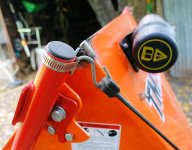
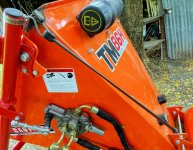
Overall the machine has exceeded my expectations in terms of performance, especially considering the BX2230 is barely above the stated minimum 15 PTO hp. The tractor also handles the 600# weight fine with just the loader on the front to counterbalance. The discharge chute has worked perfectly for everything I've chipped, with no clogging. I find the electronic tach/hr meter really handy to confirm correct PTO speed. Access to the cutter blades is a simple one bolt operation.
I did check the knife-to-bed-knife clearance and found it varies a bit among the four knives, so be sure to choose the closest one if adjusting. I noticed that the bed knife sits in a recess in the bottom of the roller housing, with a gap at its back edge. Small branch stubs seemed to catch on this if they were on the underside of the branch being fed. Not a big deal, but easy feeding is the whole point for me so I might look into adding a thin plate spanning from bed knife to just inside the hopper to make a smooth obstacle free surface.
As others have mentioned the hydraulic valve speed adjustment lever does not have a linear effect. It is numbered 1 to 10, but the feed roller will not begin to turn until around 2-1/2. From 2-1/2 to 3 the speed increases from barely moving to maximum, and stays at max from 3 to 10. So it seems the valve does not match the system flow. This just means that to run at slower than max you need to watch the roller and move the lever in very small increments, maybe 1/2 degree at a time. Once set it seems to stay put fine, plus it has a lock screw if needed.
I found that as expected the slower the feed rate the finer the chips and the fewer longish twigs that came through. So when chipping to make garden mulch I will use a low feed speed, and when just needing to get rid of prunings as fast as possible I'll use the fastest feed.
That's all for now.
-Bill
I've only used it 4+ hrs. but so far am very impressed with its quality and performance. It is light years ahead of the BearCat in ease of use and safety. The hydraulic feed roller is very aggressive and pulls material in at a controlled rate rather than dangerously jerking it out of your hands as on hand fed models. Y shaped branches feed through fine if flexible but need trimming if large and stiff. I chipped mostly live oak limbs which have very erratic side branching at all angles. The widest spreading 3/4" or larger side branches had to be trimmed but more flexible stuff went right through. Bottom line is feeding is way easier and safer than the BearCat. I would never go back to manual feed.
I was not sure how well my little BX2230 would power it, thinking I would have to reduce the feed speed on larger wood. But surprisingly it barely loads the tractor when running 3" oak or 4" pine through at the highest feed speed.
Another surprise was that the engine just briefly loads when engaging the PTO at idle. With the BearCat I had to bring the idle up a bit, then engage/disengage/engage/disengage/engage to gradually get the chipper flywheel rotating without killing the engine. The Woodmaxx runs smooth with very little vibration and is also quieter than the BearCat.
Here are the problems/quirks that I have found so far:
- As delivered the feed roller would not reverse. This was caused by the safety bar stop bolts not allowing the hydraulic valve to move into the reverse position. Correcting was just a simple adjustment, but I also added flat washers under the nuts to better hold adjustment.

- The threaded shaft between hydraulic valve and safety bar was too long, causing the bar to sit beyond the top of the hopper when in feed position. Side branches would bump the bar into neutral, stopping the feed. So I shortened the shaft so the bar sits below the rim of the hopper as shown below.

- The hopper does not line up exactly with the feed roller housing as shown below. Not a big deal, but I could see branches would sometimes hang up so I used an angle grinder to bevel the ledge.

- Small branches would sometimes catch in the slots at the top corners of the hopper as shown below, stopping the feed. This happened often enough that I welded in 1/2" round rod to close the slots.

- As others have mentioned, the safety bar would sometimes fall into neutral if a large branch started bouncing. So I added a simple rubber bungee to the bar to act as a spring, counteracting the weight of the bar. This seems to have solved the problem, but I may switch to a screen door spring for longevity.


Overall the machine has exceeded my expectations in terms of performance, especially considering the BX2230 is barely above the stated minimum 15 PTO hp. The tractor also handles the 600# weight fine with just the loader on the front to counterbalance. The discharge chute has worked perfectly for everything I've chipped, with no clogging. I find the electronic tach/hr meter really handy to confirm correct PTO speed. Access to the cutter blades is a simple one bolt operation.
I did check the knife-to-bed-knife clearance and found it varies a bit among the four knives, so be sure to choose the closest one if adjusting. I noticed that the bed knife sits in a recess in the bottom of the roller housing, with a gap at its back edge. Small branch stubs seemed to catch on this if they were on the underside of the branch being fed. Not a big deal, but easy feeding is the whole point for me so I might look into adding a thin plate spanning from bed knife to just inside the hopper to make a smooth obstacle free surface.
As others have mentioned the hydraulic valve speed adjustment lever does not have a linear effect. It is numbered 1 to 10, but the feed roller will not begin to turn until around 2-1/2. From 2-1/2 to 3 the speed increases from barely moving to maximum, and stays at max from 3 to 10. So it seems the valve does not match the system flow. This just means that to run at slower than max you need to watch the roller and move the lever in very small increments, maybe 1/2 degree at a time. Once set it seems to stay put fine, plus it has a lock screw if needed.
I found that as expected the slower the feed rate the finer the chips and the fewer longish twigs that came through. So when chipping to make garden mulch I will use a low feed speed, and when just needing to get rid of prunings as fast as possible I'll use the fastest feed.
That's all for now.
-Bill

